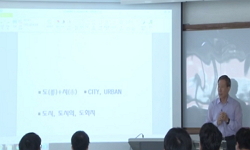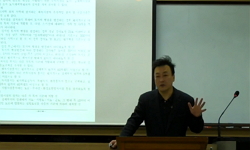대부분의 도시들은 산업 발전과 인구 증가로 인하여 열 섬을 경험하고 있다. 한국도 이런 증상을 피할 수 없으며, 많은 도시들이 여름에 계속해서 높은 기온을 보이고 있다. 이 연구의 목적...
http://chineseinput.net/에서 pinyin(병음)방식으로 중국어를 변환할 수 있습니다.
변환된 중국어를 복사하여 사용하시면 됩니다.
- 中文 을 입력하시려면 zhongwen을 입력하시고 space를누르시면됩니다.
- 北京 을 입력하시려면 beijing을 입력하시고 space를 누르시면 됩니다.
https://www.riss.kr/link?id=A105307102
- 저자
- 발행기관
- 학술지명
- 권호사항
-
발행연도
2018
-
작성언어
Korean
-
주제어
온도분포 ; 토지이용 ; 관측위치 ; 도시계획 ; Temperature Distribution ; Landuse ; Observed Location ; Urban Planning
-
등재정보
KCI등재
-
자료형태
학술저널
-
수록면
105-110(6쪽)
-
KCI 피인용횟수
0
- 제공처
-
0
상세조회 -
0
다운로드
부가정보
국문 초록 (Abstract)
대부분의 도시들은 산업 발전과 인구 증가로 인하여 열 섬을 경험하고 있다. 한국도 이런 증상을 피할 수 없으며, 많은 도시들이 여름에 계속해서 높은 기온을 보이고 있다. 이 연구의 목적은 도시에 온도 분포를 제안하는 것이다. 많은 도시들은 한두개의 관측소를 가지고 있고 그 도시의 기온을 대표하는 것으로 인식되고 있다. 도시에는 온도를 측정하는 장소에 따라 온도가 달라질 수 있다는 사각 지대가 있다. 따라서 측정 위치를 선택하는 것이 중요한 요소가 될 수 있다. 이 연구에서는 위치에 미치는 영향을 최소화하면서 가능한 한 정확하게 이러한 영역의 온도 분포를 식별하는 방법을 다룰 것이다. 온도 분포는 토지이용에 따라 다양하다는 것은 널리 알려져 있다. 토지이용 데이터를 토대로 특정 용도 분류에 따라 한 장소의 온도를 측정함으로써 더 정확한 온도 분포를 구할 수 있다. 본 연구의 결과로 온도 분포를 위성을 사용한 열영상 데이터와 비교하여 유사한 결과를 얻는 경우, 향후 여러 도시에서 동일한 결과를 얻을 수 있을 것이다. 그것은 전주의 토지 이용 구분을 조사하여 지도화했다. 20개 위치에서 측정된 온도로, 각각 다른 종류의 토지 이용을 나타낸다. 측정된 온도는 각 토지 사용에 대한 평균을 내고 그 토지에 위치시켜 그 도시에서의 온도 분포를 나타냈다. 온도분포를 위성을 이용한 열화상데이터와 비교하여 비슷한 결과가 나왔다. 이러한 연구들은 향후 도시계획에 상당한 영향을 미칠 것으로 판단된다.
다국어 초록 (Multilingual Abstract)
Most cities are suffering from heat islands because of industrial development and population growth. Korea can not avoid this phenomenon, and many cities continue to experience high temperatures in the summer. The purpose of this study is to propose a...
Most cities are suffering from heat islands because of industrial development and population growth. Korea can not avoid this phenomenon, and many cities continue to experience high temperatures in the summer. The purpose of this study is to propose a distribution of the temperature of the city. Many cities have several stations and recognize them as their representative temperature. The city has a square that says the temperature can vary depending on where it is measured. Therefore, selecting a measurement location can be a significant factor. This study will cover the method of identifying the temperature distribution in these areas as precisely as possible, with minimal impact on their location. It is widely known that the distribution of temperatures varies with land use. More accurate temperature distributions can be obtained by measuring the temperatures at a location according to a particular land use classification based on land use data. If similar results are obtained by comparing the temperature distribution as a result of this study with thermal data using satellite, the same results could be obtained in many cities in the future. It investigated landuse classification in Jeonju and mapped it. Temperature measured at 20 locations, each representing a different classification of landuse. The measured temperature was averaged for each landuse and placed on that point of the landuse to indicate the temperature distribution in the city. Similar results were obtained by comparing the temperature distribution with the deterioration data using a satellite Their results could provide valuable materials for urban planning.
목차 (Table of Contents)
- Abstract
- 1. 서론
- 1.1 연구배경 및 목적
- 1.2 연구범위 및 방법
- 2. 조사 및 분석방법
- Abstract
- 1. 서론
- 1.1 연구배경 및 목적
- 1.2 연구범위 및 방법
- 2. 조사 및 분석방법
- 2.1 기존의 온도측정 방식의 문제점
- 2.2 전주시의 현황
- 2.3 토지이용분류 및 이를 고려한 측정위치
- 3. 온도 측정결과 및 분포도
- 3.1 측정온도의 비교
- 3.2 측정온도의 분포도 및 열화상 데이터와의 비교
- 3.3 토지이용을 고려한 온도분포도
- 4. 결론
- REFERENCES
참고문헌 (Reference)
1 김상진, "풍향에 따른 건물군에서의 열환경 변화" 한국생태환경건축학회 12 (12): 27-32, 2012
2 김준현, "상수관망 모형의 비교 분석 연구" 한국환경영향평가학회 19 (19): 307-314, 2010
3 Soobong Kim, "The Urban Heat Island Phenomenon and Potential Mitigation Strategies" 6 : 63-89, 2001
4 이진덕, "Landsat 7 ETM+ 영상에서 얻은 지표온도와 지형인자의 상관성 분석" 한국콘텐츠학회 12 (12): 482-491, 2012
5 "Korea Meteorological Administration"
6 Tokyo, "Guidelines for Countermeasures Against Heat Island"
7 Seoul City, "Climate map of Seoul City"
8 Seoul City, "Climate map of Seoul City"
1 김상진, "풍향에 따른 건물군에서의 열환경 변화" 한국생태환경건축학회 12 (12): 27-32, 2012
2 김준현, "상수관망 모형의 비교 분석 연구" 한국환경영향평가학회 19 (19): 307-314, 2010
3 Soobong Kim, "The Urban Heat Island Phenomenon and Potential Mitigation Strategies" 6 : 63-89, 2001
4 이진덕, "Landsat 7 ETM+ 영상에서 얻은 지표온도와 지형인자의 상관성 분석" 한국콘텐츠학회 12 (12): 482-491, 2012
5 "Korea Meteorological Administration"
6 Tokyo, "Guidelines for Countermeasures Against Heat Island"
7 Seoul City, "Climate map of Seoul City"
8 Seoul City, "Climate map of Seoul City"
동일학술지(권/호) 다른 논문
-
- 대한건축학회지회연합회
- 대한건축학회지회연합회
- 2018
- KCI등재
-
고층건물 SRC기둥의 확률론적 기둥축소량 해석 및 보정법
- 대한건축학회지회연합회
- 송화철
- 2018
- KCI등재
-
필로티 R/C 건물의 구조설계에서 본 구조특성 조사 연구 - 부산지역에서 신축된 건물을 중심으로 -
- 대한건축학회지회연합회
- 전대한
- 2018
- KCI등재
-
리모델링 전ㆍ후 종합병원에서의 이용자 이동에 따른 공간의 감염 노출 가능성의 분석 기법에 관한 연구
- 대한건축학회지회연합회
- 김서영
- 2018
- KCI등재
분석정보
인용정보 인용지수 설명보기
학술지 이력
| 연월일 | 이력구분 | 이력상세 | 등재구분 |
|---|---|---|---|
| 2027 | 평가예정 | 재인증평가 신청대상 (재인증) | |
| 2021-01-01 | 평가 | 등재학술지 유지 (재인증) |  |
| 2018-01-01 | 평가 | 등재학술지 유지 (등재유지) |  |
| 2015-01-01 | 평가 | 등재학술지 유지 (등재유지) |  |
| 2013-01-01 | 평가 | 등재 1차 FAIL (등재유지) |  |
| 2011-01-01 | 평가 | 등재 1차 FAIL (등재유지) |  |
| 2008-01-01 | 평가 | 등재학술지 선정 (등재후보2차) |  |
| 2007-01-01 | 평가 | 등재후보 1차 PASS (등재후보1차) |  |
| 2005-01-01 | 평가 | 등재후보학술지 선정 (신규평가) |  |
학술지 인용정보
| 기준연도 | WOS-KCI 통합IF(2년) | KCIF(2년) | KCIF(3년) |
|---|---|---|---|
| 2016 | 0.29 | 0.29 | 0.29 |
| KCIF(4년) | KCIF(5년) | 중심성지수(3년) | 즉시성지수 |
| 0.27 | 0.25 | 0.534 | 0.09 |




 eArticle
eArticle






